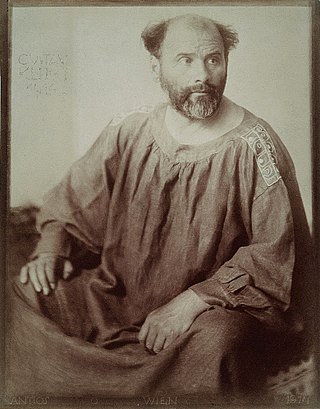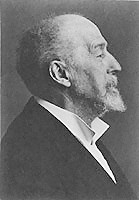Related Research Articles

Gustav Klimt was an Austrian symbolist painter and one of the most prominent members of the Vienna Secession movement. Klimt is noted for his paintings, murals, sketches, and other objets d'art. Klimt's primary subject was the female body, and his works are marked by a frank eroticism. Amongst his figurative works, which include allegories and portraits, he painted landscapes. Among the artists of the Vienna Secession, Klimt was the most influenced by Japanese art and its methods.

Otto Koloman Wagner was an Austrian architect, furniture designer and urban planner. He was a leading member of the Vienna Secession movement of architecture, founded in 1897, and the broader Art Nouveau movement. Many of his works are found in his native city of Vienna, and illustrate the rapid evolution of architecture during the period. His early works were inspired by classical architecture. By mid-1890s, he had already designed several buildings in what became known as the Vienna Secession style. Beginning in 1898, with his designs of Vienna Metro stations, his style became floral and Art Nouveau, with decoration by Koloman Moser. His later works, 1906 until his death in 1918, had geometric forms and minimal ornament, clearly expressing their function. They are considered predecessors to modern architecture.

Gerhard Marcks was a German artist, known primarily as a sculptor, but who is also known for his drawings, woodcuts, lithographs and ceramics.

The Academy of Fine Arts Vienna is a public art school in Vienna, Austria.

Hans Hollein was an Austrian architect and designer and key figure of postmodern architecture. Some of his most notable works are the Haas House and the Albertina extension in the inner city of Vienna.

Günther Förg was a German painter, graphic designer, sculptor and photographer. His abstract style was influenced by American abstract painting.

Raimund Johann Abraham was an Austrian architect.

Daniele Buetti is a Swiss visual artist who works in several modes including installation and intervention. The media he works with includes photography, sculpture, drawing, sound, video and digital forms. He is professor at University of Fine Arts Munster where he has taught since 2004. He lives and works in Zurich, Switzerland and Münster, Germany.

The Judenplatz Holocaust Memorial also known as the Nameless Library stands in Judenplatz in the first district of Vienna. It is the central memorial for the Austrian victims of the Holocaust and was designed by British artist Rachel Whiteread.

Franz West was an Austrian artist.

Abraham David Christian is a German sculptor.

The MAK – Museum of Applied Arts is an arts and crafts museum located at Stubenring 5 in Vienna's 1st district Innere Stadt. Besides its traditional orientation towards arts and crafts and design, the museum especially focuses on architecture and contemporary art. The museum has been at its current location since 1871. Since 2004 the building is illuminated in the evenings by the permanent outdoor installation "MAKlite" of American artist James Turrell. In 2015 the MAK became the first museum to use bitcoin to acquire art, when it purchased the screensaver "Event listeners" of van den Dorpel. With over 300.000 objects displayed online, the MAK presents the largest online collection within the Austrian Federal Museums. The audio guide to this museum is provided as a web-based app.

Peter Noever is an Austrian designer and curator–at–large of art, architecture and media. From 1986 to 2011 he was the artistic director and CEO of MAK—Austrian Museum of Applied Arts and Contemporary Art in Vienna.

Max Hollein is an Austrian art historian and the current Director of the Metropolitan Museum of Art in New York City. He served as Director and CEO of the Fine Arts Museums of San Francisco from July 2016, until April 2018, the Metropolitan Museum of Art announced that Hollein would become its 10th director.

Walter Lenck (1873–1952) was a versatile German artist – sculptor, draftsman, painter, architect, cellist, composer and dramatist. Escaping Nazi persecution he emigrated in 1936 to Johannesburg, South Africa, where he lived until his death. Between 1911 and 1913 he changed his original surname, Lewy, to Lenck.

The Austrian pavilion is a national pavilion of the Venice Biennale. It houses Austria's official representation during the Biennale.

Emmanuel Amos Eni, is a Nigerian-born German artist and poet. He is known as a painter, sculptor, multimedia artist, and performance artist. He is also known as "Blackman in European Kitchen". Eni is considered one of the outstanding contemporary artists in Africa and the western world.
Wang Xiaosong is a Chinese artist and professor. Having studied in Beijing and Berlin from 1983 to 1997, Wang uses a confluence of Chinese and Western art in his works.
Jean-Christophe Ammann was a Swiss art historian and curator.

Nina Hollein is an Austrian author, architect, and fashion designer based in New York City.
References
- 1 2 3 "Walter Pichler, Artist-Architect, Has Died - Art in America". Art in America. Retrieved 2018-12-02.
- 1 2 "Walter Pichler gestorben - derStandard.at". DER STANDARD. Retrieved 2018-12-02.
- ↑ "Walter Pichler | MoMA". www.moma.org. Retrieved 2018-12-02.
- 1 2 weise, martin. "Deutsche Bank, ArtMag, 58, feature, Walter Pichler's Futurist Visions". www.db-artmag.com. Retrieved 2018-12-02.
- ↑ Grady, Denise (28 July 2012). "Walter Pichler, Architect and Reclusive Artist, Dies at 75". The New York Times. Retrieved 2018-12-02.
- 1 2 3 4 5 6 7 8 "Walter Pichler". www.dorotheum.com. Retrieved 2018-12-02.
- ↑ Villarreal, Ignacio. "Grand retrospective surveying the work of Walter Pichler spanning five decades opens in Salzburg". artdaily.com. Retrieved 2018-12-02.
- ↑ Madrigal, Alexis C. (2014-03-26). "The TV Helmet". The Atlantic. Retrieved 2018-12-02.
- ↑ Pichler – Drawings. Exh. cat. The Israel Museum, Jerusalem, I.M. Cohen Graphic Gallery, Summer 1978, Cat. No. 181 (Introduction: Yona Fischer)
- ↑ "Walter Pichler Artist Architect Dies In Austria Age 76 - Artlyst". Artlyst. Retrieved 2018-12-02.